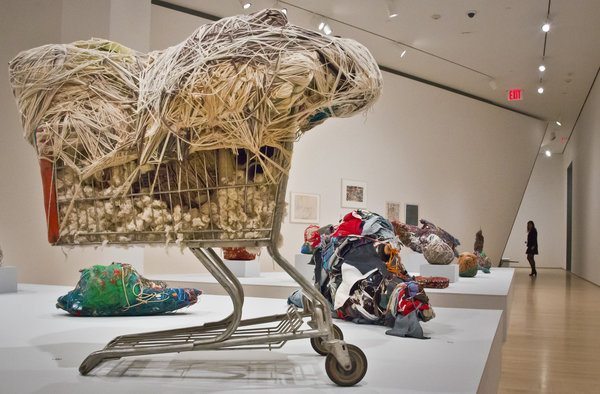The Opinion Pages An Artist Who Wrapped and Bound Her Work, and Then Broke Free
December 1st, 2014 By Lawrences Downes
 Some of Judith Scott's artwork at the Brooklyn Museum. Credit Bebeto Matthews/Associated Press
Some of Judith Scott's artwork at the Brooklyn Museum. Credit Bebeto Matthews/Associated Press
Judith Scott was an artist based in Oakland, Calif., who made abstract works from fiber and found objects. Some of them are small and slender, like a hunter-gatherer’s quiver. Some are large enough to cradle in both arms. Some you would need a shopping cart to move. One actually is a shopping cart, piled high with seemingly random objects and cocooned in white string.
That piece and many others are on display through March at the Brooklyn Museum in “Bound and Unbound,” a comprehensive survey of Ms. Scott’s art. The title is apt. Ms. Scott’s method was to use yarn, string and knotted fabric to wrap mundane materials, like crutches, bicycle wheels and plastic tubing, to the point of transformation. The shrouded objects are often left unrecognizable. The results are bafflingly beautiful.
Some works once reminded a Times critic of “the animal-shaped kono power objects of the Bamana people of Mali.” But it’s safe to say of Ms. Scott’s art that the Bamana people have nothing to do with it, and that any detected symbolism or allusion is a viewer’s projection.
To watch an excerpt from “Outsider: the Life and Art of Judith Scott,” a film by Betsy Bayha, Icarus Films, please click here.Ms. Scott had no formal training, no education to speak of, could not hear or speak and had Down syndrome. Her work exists without explanation, even as to how it should be displayed. Right-side up or down is a curator’s assumption. Every one of her 200 or so pieces is “Untitled.”
The art world does agree that the works are superb. They are shown around the world, the subject of articles, books and films. On film, you can see Ms. Scott spooling, cutting and knotting with a quilter’s patience and a genius’s dedication. She would work until her fingers were stiff and bleeding, motivated by who knows what. “Some mysterious personal juju” is how the musician David Byrne, an admirer, put it, acknowledging that it is impossible to know what was going on behind her watery eyes.
As a child, Ms. Scott was declared profoundly retarded and ineducable. At 7, she was sent to a state hospital in her home state of Ohio. She was institutionalized for 35 years. She got out only because her twin sister, Joyce, living in the Bay Area, missed her and became her guardian. In 1987, Joyce took Judith to Creative Growth Art Center, an innovative studio in Oakland for people with developmental disabilities. After nearly two years there, dabbling uninterestedly with paint, Judith found her medium.
She also found respect and deference as her talent blossomed. She became “very regal,” Joyce said, the queen of the place, with her own table and a wealth of supplies. As she wrapped her pieces — summoning the staff to remove them when she was done — she also made an artwork of herself, with colorful scarves and hats and strands of jewelry. A short documentary,“Outsider,” shows her as a woman of warmth and teasing affection in a close web of family, colleagues and friends.
Such dignity through achievement is too often the exception for people with Down syndrome, whom society prefers to infantilize and ignore. People with mental disabilities are easily pitied but seldom listened to; in the broader struggle for civil rights they remain a forgotten group.
Timothy Shriver, the chairman of Special Olympics, writes in a new book, “Fully Alive,” that people with intellectual disabilities bring those who are “normal” face-to-face with their own limitations. “In a world where we strive for independence and self-sufficiency,” he writes, “people with disabilities remind us that we are all dependent in some way.” The impulse has long been to hide these reminders away, locked in institutions or overlooked within families, sequestered from their own potential.
Sometimes, rarely, one among them hits the cosmic lottery and breaks through on her own.
Judith Scott became an artist in her early 40s. She was 61 when she died, in 2005. Her artistic vision, like all genius, is a mystery, but what made it possible is simple to explain: her own hard work, the love of a sister, the attentive support of a groundbreaking arts institution — and miles and miles of string.
Ms. Scott’s pieces are colorful, oddly shaped yet graceful, unself-consciously beautiful. That is also a good way of describing a human being, which Ms. Scott — against overwhelming odds, and the larger world’s denial, and without saying a word — declared herself to be.
______ A version of this editorial appears in print on December 2, 2014, on page A26 of the New York edition with the headline: An Artist Who Wrapped and Bound Her Work, and Then Broke Free.
